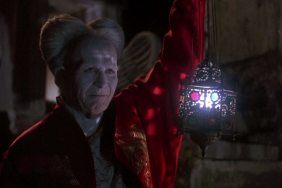
We belong to each other now, for better, for worse, like love – only real. – Frank Cotton, Hellraiser
Intellectually, love is a many splendid things. It is an emotion that overtakes, infiltrates and can consume us. While our mind can romanticize love and all that comes with it, rarely do we see the physical effects that follow it in popular entertainment. Love and romance comes with a carnal side that few films explore with any real honesty or emotion. Romantic comedies and dramas offer treaties on falling in love, but cut away before anything is truly consummated, only to have the couple wake up the next morning more invested in their love than ever before. Love in these films are painful clichés that focus on the heights of falling, but rarely anything after.
The phrase happily ever after is supposed to offer a blanket statement that comforts the audience into believing everything will be just fine as long as you fall in love. Horror films, on the other hand, have a long standing history of subverting the norm. From Bride of Frankensteins sly critique of marriage to John Carpenters attack on Reaganism in They Live, genre films have often been at the forefront of social critique, offering an appropriately horrific view of the world that the mainstream doesnt know how to tackle. In David Cronenbergs The Fly, Clive Barkers Hellraiser and Francis Ford Coppolas Dracula, we encounter the protagonist couple as their relationship faces unearthly consequences. They are at crossroads where love, desire and passion is not enough to sustain them; their bodies and minds are failing them as their emotions are put to the test.
The 1980s were a time of change, known for exacting opulence and consumerism among the masses of young university graduates who flocked to work in big business. There was also a tragic dark side with the rise of the AIDS epidemic. The free love promises of the 60s and 70s were found to be lies in the most heartrending way, with a disease that showed no remorse or discrimination. The Fly, Hellraiser and Dracula have all been readily discussed in academic terms as a response to this epidemic. While these readings still hold water, especially when looking at the period they were released, the films also speak to the cruelty and confusion of love. The realities of loving another body that is in a permanent state of decay are at the forefront of these films, while adding metaphors of addiction and abuse. In Western marriages there is often a vow read that asks if the two people will stay together in sickness or in health; these films explore the sickness.
When people deride the horror remake trend, a few regular films are brought up in defense, David Cronenbergs The Fly being one of them. The film begins with Seth Brundle (Jeff Goldbum) and Veronica Quaife (Geena Davis) meeting. Seth, a scientist, woos Veronica, a journalist, by showing her his teleportation device. As they fall in love, Veronica is still haunted by the presence of an ex-boyfriend. She leaves Seth one night assuring him that shes going to get rid of the ghost of boyfriends past and return. Seth is hurt and drunk. He decides that he is going to put himself through the machine, human testing the next stage in its development.
Unbeknownst to him, a fly slips into his pod and though the experiment is successful, his and the flys DNA is merged and he begins a horrific transformation to which Veronica is forced to bear witness. The Fly is offered up as a metaphor for AIDS, as mutation ravages Seths body transforming him into Brundlefly. However, Seth tells Veronica that the disease has a purpose and that purpose is transformation which some have drawn parallels to addiction. Seths wild mood swings, hubris and coercion trying to get Veronica to pass through the machine herself offer a horrifying glimpse into one mans change into something unrecognizable. Goldblum and Davis were dating at the time of filming and beyond the films terrific script and Cronenbergs keen eye, The Fly works because of the two actors chemistry. The early parts of the film feel like two people growing increasingly attracted to each other. So, as Seth begins to changea decision made out of the all too common feeling of jealousywe as an audience can empathize with both Seth and Veronica. When Veronica learns she is pregnant and fears what exactly is inside of her, we fear too that Seths disease is spreading. Veronica is losing not only someone she cares for, but is forced to confront him head-on to save herself. The Fly shows the horrifying vulnerability of love, how jealousy and insecurity can affect even the best love stories. Cronenberg keeps the story planted in reality, despite the horrific elements. By doing so, we feel that there will be no respite, no saving grace. Just horrific reality.

Clive Barkers directorial debut is a landmark of horror cinema. Hellraiser has become an iconic film of the 80s and spawned a ludicrous amount of sequels, while influencing countless other films. Based on Barkers novella, The Hellbound Heart, Hellraiser is the story of Frank Cotton (Sean Chapman/ Oliver Smith) a man who desires more pleasure than the world we know can provide. After acquiring and solving a mysterious puzzle box (aka the Lament Configuration) he is taken to Hell and tortured by the Cenobites, angels/demons that lean towards the S&M lifestyle. When Franks brother Larry (Andrew Robinson) and his wife Julia (Clare Higgins) move into the family house, Larry accidentally cuts himself and his blood spills on the floor in an upstairs room. From this, Frank remerges and coerces Julia, his former lover, to bring him more blood so that he can fully regenerate.
While many, including Barker himself, have pointed out that Hellraiser is about desire, carnal and otherwise, it is also about manipulation. While Julia has never gotten over her tryst with Frank, it takes a lot for the partially regenerated body of a former lover to convince someone to lure unsuspecting men to him so he can feed off them. Unlike The Fly, Barker eschews a realistic tone and opts for a dreamlike quality which play into the characters heightened feelings. Julias boring suburban life is contrasted with Franks return from Hell. He promises her, verging on the threatening, that if she does this for him, nothing will keep them apart. Julia for her part, seduces men to come back to her home. Neither Franks bloody body, all sinewy tendons and muscles that drip fluid, nor the Cenobites who threaten and deride the characters with an eternity of suffering, are the most horrific parts of the film. No, the most horrifying aspects of Hellraiser are Frank and Julia. How they manipulate, desire and hate. They will do anything to achieve their ultimate goal, including lying to each other. Franks position as the master manipulator is never clearer than with Julia, a normal woman whos pushed to extremes and ultimately seems to enjoy it. While Hellraiser is about desire, which is the impetus for all the action in the film, it is ultimately about the devastating effects of it and how it can change and warp someone until they are stripped of everything, even their humanity.
Despite the cumbersome titlewhich is effectively, Francis Ford Coppolas Bram Stokers Draculathis version of Dracula is much more in keeping with Stokers original novel, even paying tribute to the books epistolary format, which tells the story of the undead count through letters and journals. Interestingly, while the film does pay homage to the novel in many ways, Coppola and screenwriter James V. Hart chose to emphasize the relationship between Dracula (Gary Oldman) and Mina Murray (Winona Ryder) by having Mina be Draculas wife, Elisabetta, reborn. In the novel, Mina despises Dracula because he turned her friend Lucy into a vampire. Here, with Mina reimagined as Draculas long lost soulmate, Dracula is humanized and the film becomes a tale of a love lost, painful memories and finally being released from that pain. When we first encounter Dracula, he is aged, decrepit and much more of a traditional monster. As he learns of Minas existence, and travels to London to be with her, he transforms into a younger version of himself to woo her, in hope some version of her past self might remember him. However, the logistics of carrying on a long term relationship with someone who is undead does have several drawbacks. Mina wants to be with Dracula, but he worries about turning her into a vampire. It is eventually her that initiates the change so they can be together, signifying their shared love.

Coppola insinuates Dracula became the way he is because he had love and lost it. The films events then follow the lengths he will go to in order to find it again, even if it takes centuries. Like The Fly and Hellraiser, Dracula deals in the worst parts of love. While it contains moments of romance and sensuality, it is spurred on by jealousy and rejection. It also offers a complex look at love and aging. After Mina has begun her transformation, she stills looks as youthful as ever, while Dracula returns to his elderly state. After a fight he is wounded and Mina helps him back into his castle as he struggles. She has committed herself to him and the men chasing him let her go. He is dying, and it is painful and ugly; The Notebook this is most definitely not. Minas ultimate sacrifice for love is to release him from his suffering after they have just found each other. The moment which ends the film is a heartbreaking one of true humanity in a glossy studio film. It is both as operatic as film can be and as tragic as life is.
The three of these films are about the horrifying reality of love. What is it to offer ourselves to someone else and find out a terrifying truth or a shocking reality in the process? In these films, the camera doesnt stop filming once the couples commit. Cronenberg, Barker and Coppola reveal the ever after. They present us a fantastical reality which we can emotionally understand and relate to. The Fly, Hellraiser and Dracula show us the extremes that love can push us toward, things we would all do again and again and again.
—
Alexandra West is a freelance horror journalist who lives, works, and survives in Toronto. Her work has appeared in the Toronto Star, Rue Morgue, Post City Magazine and Offscreen Film Journal. In December 2012, West co-founded the Faculty of Horror podcast with fellow writer Andrea Subissati, which explores the analytical side of horror films and the darkest recesses of academia.









